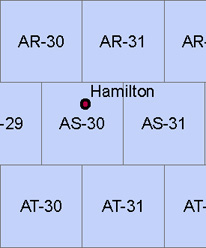
The concept of creating an aerial view of a land mass has been around for thousands of years but much has changed in the process of creating them just in the past 40 years since the creation of the pavilion map floor. The greatest stretch has been in the development of technology, which was just beginning to take hold in the mid 60’s
With the advent of computer mapping software, the development of the Geographic Positioning System (GPS) and the improvement of Satellite photography, these elements have made it so that today even the average person can create their own map for a specific purpose in either printed or digital form with little or no cost.
One of the most significant contributions to the field of mapping has been the development of Geographic Information Systems (GIS). A geographic information system (GIS), also known as a geographical information system or geospatial information system, is a system for capturing, storing, analyzing and managing data and associated attributes which are spatially referenced to the Earth. The concept works on the notion that different variables in a complex system can be compared to each other to determine relationships.
While the concept of overlaying information into a map to identify trends or patterns has been around for a long time using traditional hand drawn maps, the synthesis of mapping and computing resulted in a much more powerful resource. 1962 saw the first true operational GIS. The Canada Geographic Information (CGIS) commences, lead by Roger Tomlinson was used to analyze Canada's national land inventory and pioneered many aspects of GIS.
In 1964 during the years of the fair, The Harvard Laboratory for Computer Graphics and Spatial Analysis was laying its foundation with the development of general purpose mapping software in the by Howard Fisher.
With the development of digitized GIS, softwares were created which allowed a wide range of companies and organizations to record and map different types of data. Once GIS software gained a foothold the sky was the limit as far as what could be mapped and what data could be applied.
In the very recent past, within the fields of historic preservation, the use of digitized GIS has begun to take hold allowing professionals within the field to map historical change for neighborhoods and communities.
Architectural Conservation as a sub-category of Historic Preservation has also adopted GIS technology as a method for recording condition of buildings and objects. In the past conservators would “map” existing visible conditions such as soiling and decay onto a drawing of a building through the use of overlaying sheets of information. This process was a rudimentary GIS and the incorporation of GIS softwares was a simple next step. For the Texaco Road map floor, GIS software was used to map the existing conditions of the terrazzo onto the area of Long Island as a means to identify connections between different decay mechanisms as a way to determine not just the obvious effect of deterioration but also the less apparent causes of that decay. The process which is standard in the field of conservation took on a new level of curiosity though when it became apparent that mapping software was being used to map conditions of material decay onto the physical surface of the world’s largest map.